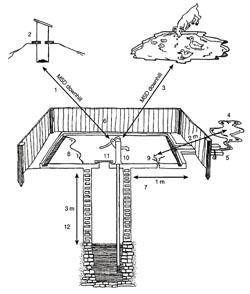16.5 Sanitary survey of wells
Wells should have a well casing (a liner pipe or tube or stone wall), protective devices such as good fences, and warning signs to discourage human and animal activities that might disturb the well area. Figure 16.3 shows what you should be looking for when you are doing a sanitary survey of a well, and Box 16.1 has a list of questions to be asked. The numbers in the diagram demonstrate particular points and correspond to the questions in the checklist. Answering ‘yes’ to any of the questions would be a cause for concern.
Note that the minimum safe distance (MSD) between the well and potential sources of pollution will vary depending on the local conditions, particularly the soil type, geology, hydraulic gradient and slope of the land. It should never be less than 15 metres but 30–50 metres is recommended.
In addition to the observations of the physical condition of the well and its surroundings, you should also find out and make a note of the maintenance programme for the well, for example, the frequency of cleaning and disinfection.

Box 16.1 Sample checklist for well water sanitary inspection
Name of Health Post ------------
Village name and location of well/handpump
-----------------------
Questions to be asked during survey:
- Is there a latrine within 15 m of the well and handpump?
- Is the nearest latrine on higher ground than the handpump?
- Are there any animal excreta or rubbish within 15 m of the handpump?
- Does the drainage channel contain stagnant water within 2 m of the handpump?
- Is the drainage channel broken allowing a pool of water to form?
- Does the wall or fencing around the handpump have any breaks that would allow animals in?
- Is the concrete floor less than 1 m wide all around the handpump?
- Are there any pools of water on the concrete floor around the handpump?
- Does the concrete floor around the handpump have any cracks that could let water in?
- Is the handpump loose at the point of attachment to the base which could let water enter the casing?
- Is the cover of the well unhygienic (unclean)?
- Are the walls of the well poorly sealed at any point for 3 m below ground level?
Name ------------
Signature ------------
Date ------------
16.4 Source water quantity
